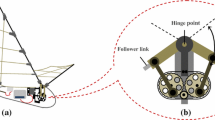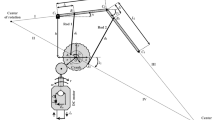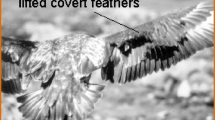Abstract
The aim of this article is to present an efficient dynamical model for simulating flapping robot performance employing the bond graph approach. For this purpose, the complete constitutive elements of the system under investigation, including the main body and accessories, flapping mechanism, flexible wings and propulsion system consisting of a battery, DC motors and gear boxes, are considered. A complete model of the system was developed appending bond graph models of the subsystems together utilizing appropriate junctions. The wings were also modeled using ANSYS only for an initial evaluation. Moreover, a computer model was developed employing the block-oriented structure of Simulink in MATLAB software for simulation studies. Further investigation was performed developing a finite element model of the flexible wing and multi-body simulation tool. SimMechanics toolbox of MATLAB software was used to investigate whether the equations obtained from the bond graph were extracted correctly and whether the relationships between all the subsystems are maintained so that they lead to a logical motion for the flapping wing. The very good agreement between the results achieved from various models illustrates the validity and accuracy of the proposed bond graph model in this study. As a result, the offered approach presents a comprehensive and efficient model to obtain a clear insight into the power flow between the subsystems included in a flapping robot and provides helpful information for the design of such systems.













Similar content being viewed by others
Abbreviations
- A :
-
Cross-sectional area of the wing
- C :
-
Capacitance
- EI:
-
Flexural rigidity
- e :
-
Effort
- F :
-
Force
- f :
-
Flow
- f(t):
-
Time response function
- G :
-
Module of gyrator
- GY:
-
Gyrator
- h :
-
Angular momentum
- I :
-
Area moment of Inertia
- i :
-
Current
- J :
-
Mass moment of inertia
- L :
-
Inductance
- l :
-
Wing span
- m :
-
Mass
- m n :
-
Modal masses
- MTF:
-
Modulated transformer
- p :
-
Linear momentum
- q :
-
Displacement
- R :
-
Resistance
- S e :
-
Source of effort
- S f :
-
Source of flow
- T :
-
Module of transformer
- TF:
-
Transformer
- T :
-
Time
- v :
-
Voltage
- V x :
-
Velocity in horizontal direction
- V y :
-
Velocity in vertical direction
- w(x, t):
-
Deflection of the wing
- x 1 :
-
Force point of action
- Y(x):
-
Mode shape function
- τ :
-
Torque
- ω :
-
Angular velocity
- θ :
-
Flapping angle
- α :
-
Rod’s angle with vertical direction
- ρ :
-
Material density
- β n :
-
Modal stiffnesses
- ω n :
-
Mode frequencies
References
Karimian S (2011) Specification and analysis of hybrid flapping wing applications. Dissertation, Sharif University of Technology
Kim DK, Kim HI, Han JH, Kwon KJ (2008) Experimental investigation on the aerodynamic characteristics of a bio-mimetic flapping wing with macro-fiber composites. J Intell Mater Syst Struct 19(3):423–431. doi:10.1177/1045389X07083618
Liu H (2001) Computational mechanical modeling of biological fluid dynamics. Adv Biomech 5(8):200–213
Daniel T, Combes S (2002) Flexing wings and fins: bending by inertial or fluid dynamic forces. Int Comp Biol 42:1044–1049
Maglasang J, Isogai K, Goto N (2006) Aerodynamic study and mechanization concept for flapping-wing micro aerial vehicles. Mem Fac Eng Kyushu Univ 66(1):26–31
Isogai K, Harino Y (2007) Optimum aeroelastic design of a flapping wing. J Aircraft 44(6):344–351. doi:10.2514/1.27142
Delaurier JD (1993) An aerodynamic model for flapping-wing flight. Aeronautical 97(964):125–130
Orlowski C, Girard A, Shyy W (2009) Derivation and simulation of the nonlinear dynamics of a flapping wing micro-air vehicle. The European Micro Aerial Vehicle Conference and Flight Competition
Mazaheri K, Ebrahimi A (2010) Experimental investigation of the effect of chord wise flexibility on the aerodynamics of flapping wings in hovering flight. J Fluids Struct 26(4):544–558. doi:10.1016/j.jfluidstructs.2010.03.004
Feiffer ATP (2010) Ornithopter flight simulation based on flexible multi-body dynamics. J Bionic Eng 7(1):102–111. doi:10.1016/S1672-6529(09)60189-X
Zhu C, Muraoka K, Kawabata T, Cao C, Fujimoto T, Chiba N (2006) Real time animation of bird fight based on aerodynamics. Soc Art Sci 5(1):1–10
Ferreira M (2010) Modeling and control of a dragonfly-like robot. J Contr Sci Eng. doi:10.1155/2010/643045
Han JH (2008) Ornithopter modeling for flight simulation. In: IEEE international conference on control, automation and systems, pp 1773–1777. doi: 10.1109/ICCAS.2008.4694517
Ho S, Nassef H, Pornsinsirirak N (2003) Unsteady aerodynamics and flow control for flapping wing flyers. Prog Aerosp Sci 39(8):635–681. doi:10.1016/j.paerosci.2003.04.001
Heathcote S, Martin D, Gursul I (2004) Flexible flapping airfoil propulsion at zero free stream velocity. AIAA J 42:2196–2204. doi:10.2514/6.2003-3446
Barut A, Das M, Madenci E (2006) Nonlinear deformations of flapping on a micro air vehicle. AIAA Paper. doi:10.2514/6.2006-1662
Sibilski K, Pietrucha J, Zlocka M (2007) The comparative evaluation of power requirements for fixed, rotary and flapping wings micro air vehicles. AIAA. doi:10.2514/6.2007-6498
Ebrahimi A, Karimian S, Shidaei A, Okhovat S, Dehghadani M (2005) Primarily design of TADBIR ornithopter, Aerospace Research Centre. Sharif University of Technology, TR-01, A1-10
Karnopp DC, Margolis DL, Rosenberg RC (2000) System dynamics modeling and simulation of mechatronic systems. Wiley, Canada
Fritz T, Long L (2004) Object-oriented unsteady vortex lattice method for flapping flight. J Aircr 41(6):1275–1290. doi:10.2514/1.7357
Pourtakdoust SH, Karimain Aliabadi S (2012) Evaluation of flapping wing propulsion based on a new experimentally validated aeroelastic model. Scientia Iranica B 19(3):472–482
Xu M, Wei M, Yang T, Lee YS, Burton TD (2011) Nonlinear structural response in flexible flapping wings with different density ratio. In: 49th AIAA aerospace sciences meeting including the New Horizons forum and aerospace exposition, AIAA 2011–376
Mukherjee I, Omkar SN (2011) An analytical model for the aeroelasticity of insect flapping. In: 52nd AIAA/ASME/ASCE/AHS/ASC Structures, Structural Dynamics and Materials Conference, AIAA 2011–2012
Beards CE (1996) Structural vibration: analysis and damping. Arnold, a member of the Hodder Headline Group, Britain
Daniel T, Combes S (2002) Flexing wings and fins: bending by inertial or fluid dynamic forces. Int Comp Biol 42:1044–1049
Combes SA, Daniel TL (2003) Into thin air: contributions of aerodynamic and inertial-elastic forces to wing bending in the hawk moth manduca sexta. Exp Biol 206:2999–3006
Jahanbin Z (2013) Developing a method for the dynamic analysis of flexible flapping wing. Dissertation, Sharif University of Technology
Beheshtkar N (2011) Dynamic simulation of the propulsion system of the mechanical birds. Dissertation, Sharif University of Technology
Author information
Authors and Affiliations
Corresponding author
Additional information
Technical Editor: Glauco A. de P. Caurin.
Appendix: Bond graph models used to derive the dynamic equations of motion
Appendix: Bond graph models used to derive the dynamic equations of motion
Figure 14 shows the numbered bond graph model of a DC motor attached to a crank-rod mechanism and a rigid beam wing.
Figure 15 shows the labeled bond graph model of a DC motor attached to a crank-rod mechanism and an elastic beam wing.
Figure 16 illustrates the complete numbered bond graph model of the flapping bird equipped with the elastic wings and driven by a pair of DC motors and crank-rod mechanism and attached to the main body. All the bonds in the graphs were named in order to derive the dynamic equations of motion.
Rights and permissions
About this article
Cite this article
Jahanbin, Z., Selk Ghafari, A., Ebrahimi, A. et al. Multi-body simulation of a flapping-wing robot using an efficient dynamical model. J Braz. Soc. Mech. Sci. Eng. 38, 133–149 (2016). https://doi.org/10.1007/s40430-015-0350-4
Received:
Accepted:
Published:
Issue Date:
DOI: https://doi.org/10.1007/s40430-015-0350-4







